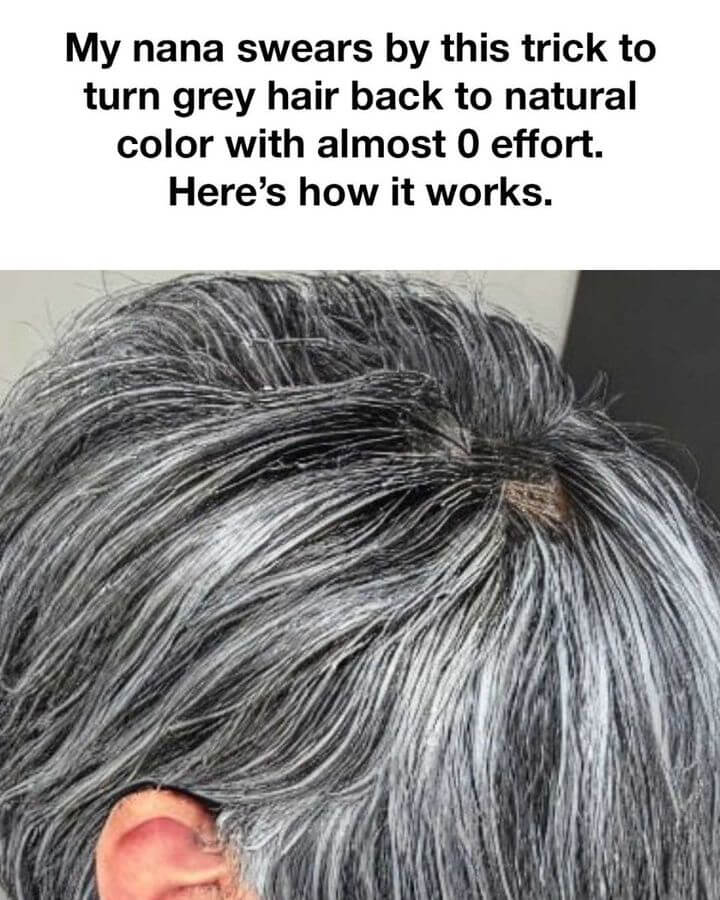As we get older, it’s common to notice those first strands of grey hair making an appearance. While some wear their greys with pride, others prefer to hold on to their natural shade. My nana, who has always trusted in natural remedies passed down through generations, revealed a simple trick she uses to maintain her dark hair—and it takes almost no effort.
After seeing her results firsthand, I knew I had to share this method. Here’s how it works and why you might want to give it a try.
What Causes Hair to Turn Grey?
Before diving into Nana’s method, it helps to understand why hair loses its color. The pigment responsible for hair color is called melanin, produced by cells known as melanocytes located in hair follicles. As we age, melanin production declines, resulting in grey or white strands. Factors such as genetics, stress, hormonal fluctuations, and a lack of proper nutrients can speed up this process.
While it’s commonly believed that greying is permanent, emerging research suggests that, under certain conditions, hair may regain its pigment. That’s where Nana’s trusted remedy comes in.
The Natural Trick: Black Sesame Seeds
Nana’s approach to maintaining youthful hair is wonderfully straightforward—she eats black sesame seeds every day. Now in her 70s, her hair still looks naturally dark and full of life. Here’s why this tiny seed could make a big difference:
1. Packed With Essential Nutrients
Black sesame seeds are a rich source of vital nutrients like copper, iron, magnesium, phosphorus, and vitamins B1 and E. These nutrients support healthy hair growth and pigmentation. In particular, copper is directly involved in melanin production, which means boosting your intake might help restore hair color.
2. Loaded With Antioxidants
These seeds contain powerful antioxidants such as sesamin and sesamolin. These compounds help protect cells from oxidative damage—a key contributor to premature greying. By defending the melanocytes from this damage, antioxidants may slow or even reverse the process.
3. Supports Scalp Health
For hair to grow healthy and strong, the scalp needs to be well-nourished. Black sesame seeds promote better circulation, which helps deliver nutrients to hair follicles. This can keep them functioning well and help preserve their ability to produce color.
How to Add Black Sesame Seeds to Your Routine
Integrating this remedy into your daily life is effortless and flexible. Here are a few simple ways to use black sesame seeds:
- Eat Them Raw: Take a tablespoon of raw black sesame seeds daily. You can eat them on their own or sprinkle them over your meals like yogurt, cereal, or salads.
- Blend Into Smoothies: Add a spoonful to your morning smoothie or protein shake for a subtle nutty flavor.
- Make a Paste: Grind the seeds with a little honey or water to create a paste. Eat it as is or spread it on toast.
- Use the Oil: Though eating whole seeds is best, you can also incorporate black sesame oil into your cooking or use it as a salad dressing.
Is There Scientific Support?
While Nana’s method might sound like a traditional home remedy, some scientific findings back it up. Nutrients such as copper and B vitamins found in black sesame seeds are associated with hair pigment and overall hair health. Though more research is needed for definitive proof, the existing studies offer promising insights.
For instance, a 2019 study in the Journal of Clinical and Aesthetic Dermatology noted that diets rich in antioxidants can help reduce oxidative stress in hair follicles—one of the causes of premature greying. Since black sesame seeds are full of antioxidants, they could contribute to keeping your natural hair color longer.
What Results Can You Expect?
If you try Nana’s trick, remember that it takes time. Restoring color naturally is a gradual process and often depends on the individual. Most people notice subtle improvements after several weeks or months of consistent use.
Your results may vary based on the root cause of your greying and how your body processes nutrients. But even if your hair doesn’t change dramatically, the added health benefits of these nutrient-packed seeds make them worth including in your diet.
Other Natural Tips for Hair Color Maintenance
Black sesame seeds are a great start, but combining them with a few other habits can boost your results:
- Follow a Nutritious Diet: Eat foods rich in zinc, iron, copper, and B vitamins to support healthy hair.
- Stay Well-Hydrated: Drink enough water daily to keep your scalp and hair hydrated.
- Reduce Stress: Stress can impact melanin production. Activities like meditation, exercise, or hobbies can help manage it.
- Avoid Harsh Chemicals: Limit the use of chemical-based dyes and treatments that may harm hair health.
- Massage the Scalp: Regular scalp massages can stimulate blood flow, helping nourish the follicles.
Final Thoughts
Nana’s go-to trick for bringing back natural hair color—eating black sesame seeds—offers a gentle, low-effort, and all-natural approach to healthier, more vibrant hair. While it may not be an instant fix, the combination of nutrients and antioxidants can benefit both your hair and overall wellness over time.
So, if you’re looking for a natural way to care for your hair, give black sesame seeds a shot. With a little patience and consistency, you might be pleasantly surprised by what nature—and Nana’s wisdom—can do!
